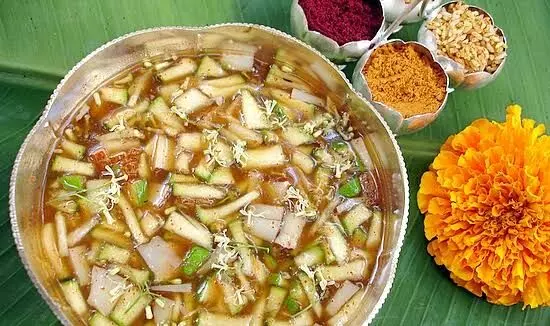Happy Ugadi: How to cook Ugadi Pachadi at home
People clean their homes ahead of the festival and decorate them with fresh mango leaves and rangolis
By Beyniaz Edulji
How to cook Ugadi Pachadi at home
Hyderabad: Ugadi will be celebrated on March 30. It marks the first day of the Hindu calendar month of Chaitra. Ugadi was recognized by the Indian mathematician Baskaracharya as the beginning of the New Year in the 12th century, since it marks the arrival of spring. The ‘Yug’ of Yugadi means an era, and ‘Adi’ is associated with something new. The day signifies a new beginning and holds astrological importance for predicting the year.
Celebrated in Southern States
Ugadi, also known as Yugadi, is a Hindu festival celebrated with great enthusiasm in the southern states of Andhra Pradesh, Telangana and Karnataka. Ugadi coincides with Chaitra Navratri, which is a nine-day festival celebrated in north India dedicated to Goddess Durga.
Known by other names
In Maharashtra, it is called Gudi Padwa, in Tamil Nadu, it is known as Puthandu, in Assam as Bihu, in Punjab as Vaisakhi, in Odisha as Pana Sankranti, and in West Bengal as Naba Barsha.Other cultures also celebrate this day under different names like Cheti Chand for Sindhis, Sajibu Nongma Panba for Manipuris and Nyepi for the Hindu community of Bali, Indonesia.
Though the Ugadi Pachadi is more typical of this festival in South India, others have their traditional foods to celebrate this day with.
Rituals
Rituals are beginning the day with an oil bath, which is believed to clean and purify the body and soul. Special prayers are offered to seek blessings for the new year. People clean their homes ahead of the festival and decorate them with fresh mango leaves and rangolis. Special cultural events and processions are organized on this day. Astrologers predict the fortunes of the year ahead based on the new Samvatsara.
Ugadi Pachadi and its significance
The most significant part of Ugadi in South India is preparing and consuming a special dish called Ugadi Pachadi, which is made with six tastes: spice, salty, sweet, two types of sour, and bitter. The flavours symbolise the bittersweet experiences of life, as it is about accepting these. Ugadi Pachadi is a festive drink which is a concoction of 6 varied flavors, corresponding to the 6 different emotions that human beings possess. This is what the underlying significance of the festival of Ugadi or Gudi Padwa is also based on.
Traditionally, the Ugadi Pachadi is the first dish offered to the family deities on this special festival, after which it is consumed as a prasad by devotees in order to seek blessings from them.
The 6 ingredients with different flavors that are added in the Ugadi Pachadi, further linked to the 6 human emotions are:
Tamarind is used for its sour taste, which signifies unpleasantness.
Jaggery for sweet taste signifies joy or happiness.
Unripe or raw mango for a tangy, astringent taste signifies surprise.
Neem flowers have for bitter taste which signifies sadness.
Black pepper for a spicy taste to signify anger.
Salt for salty taste, which signifies fear.
Ugadi Pachadi Recipe
Ingredients
1 teaspoon tamarind
¼ cup water for soaking tamarind
⅓ cup water(This should be added later)
¼ cup jaggery, chopped
⅓ cup raw mangoes, finely chopped.
2 tablespoons neem flowers
¼ teaspoon black pepper powder
¼ teaspoon salt or add more to taste
Method
Soak the tamarind in water for half an hour. Then, squeeze the tamarind pulp, strain, and keep aside. In a large bowl, add the tamarind pulp. Also, add ⅓ cup water. Add the chopped jaggery. Mix well with a spoon so that all the jaggery dissolves. Then add the finely chopped raw mangoes and neem flowers. Season with salt and black pepper powder. Mix again.